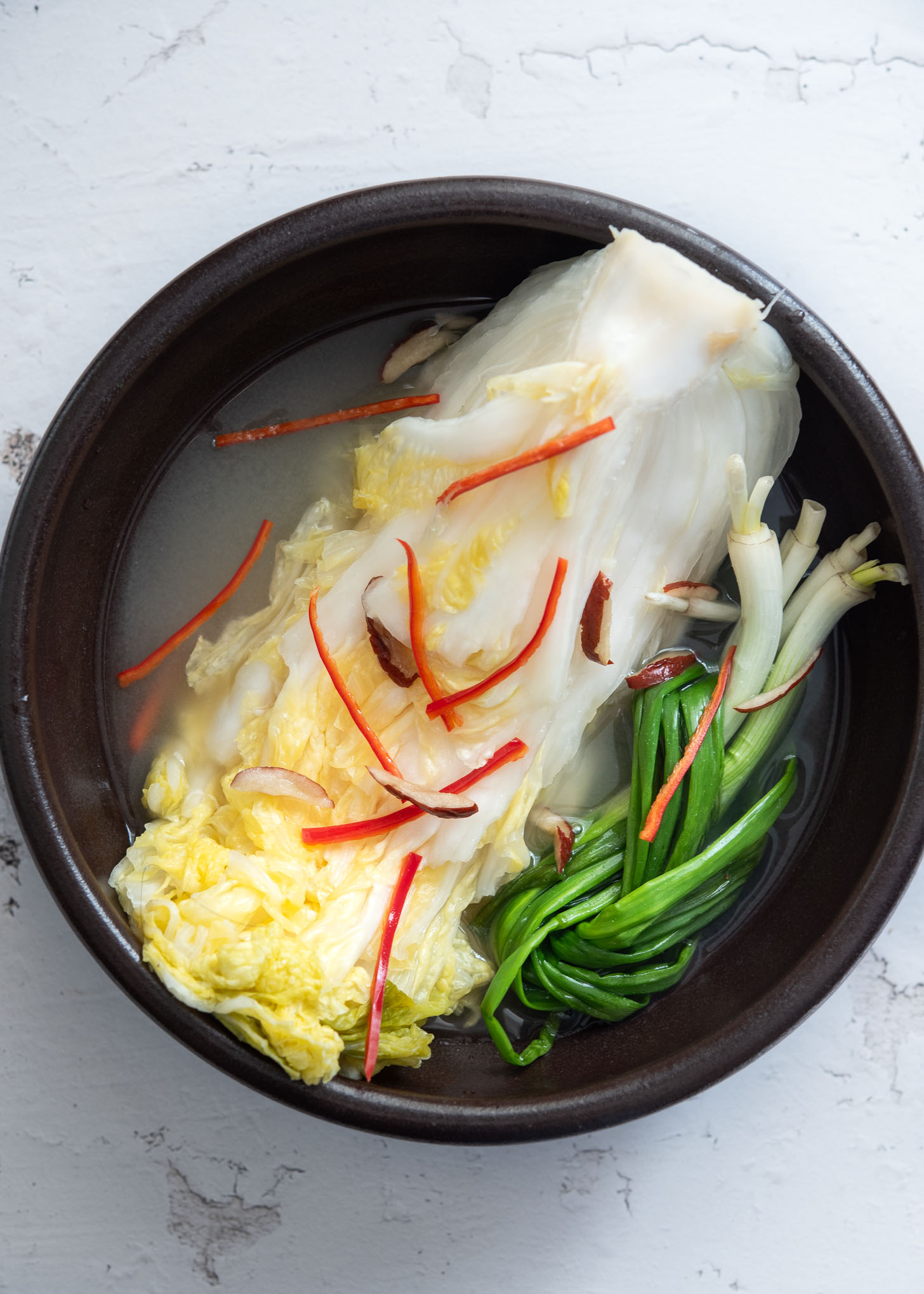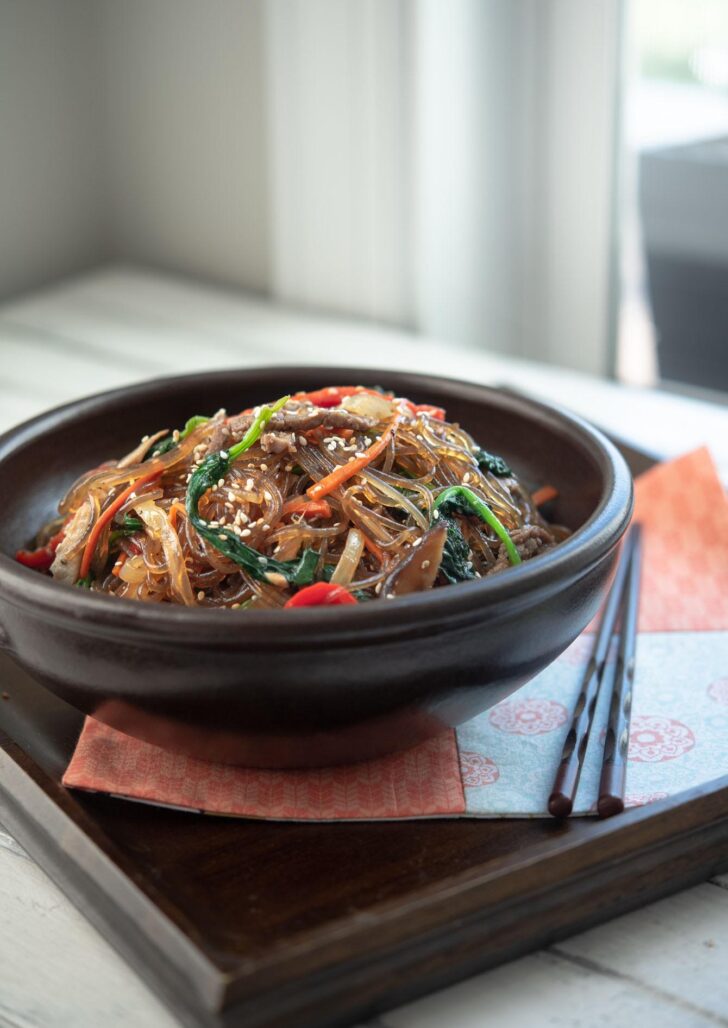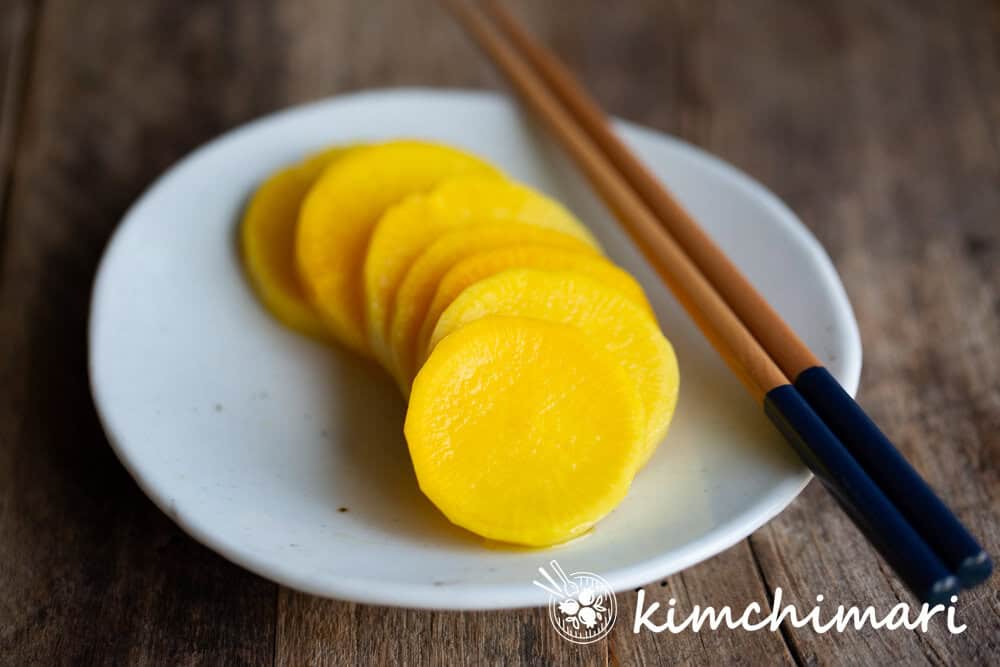You are here: Home > Kimchi > Easy White Kimchi (Baek Kimchi) – Non-Spicy and Refreshing
This easy white kimchi (baek kimchi) recipe is perfect for anyone who loves mild, non-spicy kimchi with a clean, crisp flavor. Made with napa cabbage and a refreshing brine, it’s simple to prepare, gochugaru-free, and ready to enjoy after a quick fermentation.

When my children were little, they were curious about kimchi because they saw me eating it so often. But traditional spicy kimchi was too much for their young taste buds. To help them enjoy it, I used to rinse regular kimchi in water to remove the spice, making it milder and easier for them to eat.
That’s when I decided to try making white kimchi, also known as “baek kimchi“. This non-spicy kimchi was the perfect way to introduce my kids to the world of fermented Korean foods. I loved watching them happily munch on it alongside all kinds of Korean dishes.


Get new recipes via email:
Thank you for subscribing!
White kimchi isn’t just a favorite in my household—many Korean parents use it to help their children develop a taste for kimchi at a young age. Its mild, refreshing flavor makes it a great choice for anyone not ready for the heat of spicy kimchi.
With this easy white kimchi recipe, you can make your own homemade baek kimchi right in your kitchen. It’s perfect for kids, beginners, or anyone looking for a milder version of this classic Korean staple. Enjoy the goodness of kimchi without the spice!

What is White Kimchi?
White kimchi, or baek kimchi (백김치), is a mild, non-spicy version of traditional napa cabbage kimchi. Made without red chili pepper flakes (gochugaru), it uses ingredients like Korean pear, radish, and jujubes to create a naturally sweet and refreshing flavor, perfect for kids or anyone who prefers a non-spicy option.
White kimchi also features a more liquid brine than traditional spicy kimchi. Once fermented, the brine develops a bright, clean, and refreshing taste, enhancing the cabbage’s crisp texture.
It’s particularly enjoyable as a cooling side dish during warmer months. This mild kimchi is great with soups, rice, or enjoyed on its own—an easy and delicious way to experience fermented Korean food without the spice.

Why You’ll Love This White Kimchi Recipe
- This white kimchi recipe focuses on simplicity, letting the clean, crisp flavor of fermented cabbage shine. By skipping the heavy vegetable filling, you can fully enjoy the cabbage’s natural taste and texture while making the process quicker and easier.
- The highlight of this recipe is the brine, which develops a bright, refreshing, and umami-packed flavor during fermentation. Using mineral water and a rice flour porridge made with sea kelp stock ensures a perfectly balanced and delicious brine.
- For garnishes, I like to use tied green onion bunches, dried jujubes, and julienned fresh red chili for a pop of color and added flavor as the kimchi ferments. Feel free to customize with sliced green onion, sweet red pepper, or leave them out entirely to suit your preference.
Essential Recipe Ingredients
- Napa Cabbage: Choose firm, crisp cabbage with tightly packed yellow leaves inside. Remove the tough, dark green outer leaves to reveal the tender, pale-yellow layers for the best results.
- Korean Coarse Sea Salt: Use high-quality Korean sea salt, which is essential for properly salting the cabbage to achieve the right texture and ensure successful fermentation.
- Sea Kelp Stock: This rich, umami-packed base forms the foundation of the kimchi brine, giving white kimchi its signature depth of flavor.
- Fish Sauce: Anchovy-based fish sauce is the most commonly used type for white kimchi. If you’d like to make this recipe vegan, you can substitute it with Korean soup soy sauce, as shown in my vegan kimchi recipe. Keep in mind that the flavor will be slightly different.
- Sweet Rice Flour: Helps speed up the fermentation process and adds depth to the brine. Mix it with sea kelp stock and simmer until it thickens into a smooth, runny syrup.
- Aromatics: A blend of Korean pear, Korean radish, onion, garlic, and ginger provides natural sweetness and layers of subtle flavor as the kimchi ferments.
- Mineral Water: Using mineral water instead of tap water enhances the depth and clarity of the brine, resulting in a clean and refreshing taste in the final kimchi.
- Garnishes (Optional): Add a bunch of green onions tied into knots, seeded fresh red chili or sweet red pepper for a pop of color, and dried jujubes for a touch of traditional flavor. These garnishes can be adjusted or omitted based on your taste.
How to Make White Kimchi (Baek Kimchi)
Salt Brine the Cabbage


Prepare the Cabbage: Start by slicing into the stem of the napa cabbage with a knife, then gently pull it apart with your hands to split it. Repeat the process to quarter the cabbage in the same way. This method helps keep the leaves intact.


Prepare the Brine: In a large bowl, dissolve Korean coarse sea salt in water. Submerge the cabbage completely, ensuring the salt water reaches all the layers between the leaves.


Salt the stems: Sprinkle extra salt on the thick stem parts of the cabbage. Place the cabbage back in the brine and weigh it down with a heavy object to keep it submerged. Let it soak for 2 hours, turning the cabbage halfway through.


Rinse and drain: Rinse the salted cabbage thoroughly with water to remove excess salt. Let it drain in a colander.
Sea Kelp Stock and Sweet Rice Porridge


Simmer the stock: Boil a piece of sea kelp in water for a few minutes and remove the kelp.
Make the porridge: Whisk in sweet rice flour and simmer over medium heat until it thickens into a smooth, runny syrup-like porridge. Let it cool completely.
Prepare the Aromatics


Blend the aromatics: Dice onion, Korean radish, pear, garlic, and ginger. Blend them in a blender until smooth.


Strain for a clean brine: Pour the aromatic puree into a fine kitchen bag or linen, then squeeze out the liquid into a kimchi container, leaving behind the fibrous residue.
Make the Kimchi Brine


Combine brine ingredients: Mix the cooled rice porridge with the strained aromatic liquid. Add Korean anchovy sauce, salt, sugar, Korean plum extract, and mineral water. Whisk well until everything is combined. Taste the brine and adjust the salt as needed.
Assemble the Kimchi


Soak the cabbage: Submerge the brined cabbage in the prepared kimchi brine. Spoon the liquid over the leaves to ensure they are well coated.
Add optional garnishes: Tuck tied green onions between the cabbages. Sprinkle with thinly sliced red chili (or sweet red pepper) and dried jujubes for color and added flavor. Cover the container with a lid.

Tips for Fermenting and Serving
Let the baek kimchi sit at room temperature for 2-3 days to kickstart fermentation, adjusting the time based on the weather. Once bubbles begin to form and the flavors start to develop, transfer the container to the refrigerator to ferment for another 3-5 days.
As the kimchi matures, it will release a refreshingly tangy flavor that gets better with time. Enjoy it until it reaches your preferred level of tanginess. White kimchi will keep for about a month in a standard refrigerator or up to 3 months in a kimchi fridge.
To serve, slice the kimchi as needed, place it in a bowl, and ladle some of the flavorful brine over the top. In Korean barbecue restaurants, white kimchi is often paired with samgyupsal (grilled pork belly), as its mild, clean flavor balances the richness of the meat and acts as a palate cleanser. It’s also delicious with soups, rice, or simply enjoyed on its own.
Common Problems When Making White Kimchi (And How to Solve Them)
- Lack of Flavor: To enhance the flavor of your white kimchi, use a rich, umami-packed base like sea kelp stock or high-quality fish sauce. Adding ingredients like Korean pear can introduce natural sweetness, balancing the flavors and making the kimchi more vibrant.
- Over-Salting or Under-Salting: Getting the right salt level is crucial for successful fermentation. Carefully measure the coarse sea salt, and make sure to rinse the cabbage thoroughly after salting to avoid excessive saltiness. If the kimchi ends up under-salted, it may not ferment properly or develop its full flavor.
- Slimy Texture: A slimy texture often results from improper fermentation. To prevent this, keep your kimchi at room temperature for 2-3 days to allow fermentation to start before moving it to the refrigerator. Also, avoid overhandling the cabbage during preparation, as this can damage the texture.
- Too Sour: If your white kimchi becomes too tangy from over-fermentation, don’t toss it out! Overly sour kimchi can still be delicious when used in soups, stews, or fried rice, where the acidity can add a unique depth of flavor.
Easy White Kimchi (Baek Kimchi)
Servings: 20 people
Prep Time: 2 hours 30 minutes
This easy white kimchi (baek kimchi) recipe is perfect for those who love mild, non-spicy kimchi with a clean, crisp flavor. Made with napa cabbage and a refreshing brine, it’s simple, chili-free, and ready after quick fermentation.
Salt brine
- 1 head (5 lb, 2.3 kg) napa cabbage, quartered
- 10 cup (2.5 liter) water
- 1 cup (225g) Korean coarse sea salt, divided
sweet rice porridge
- 4 cup (1 liter) water
- 1 large piece dried sea kelp (dashima)
- 2 tbsp sweet rice flour, or plain wheat flour
Aromatics
- 1/2 Asian pear, peeled and diced
- 1/2 lb Korean radish or daikon, peeled and diced
- 1/2 large onion, diced
- 7 cloves garlic
- 1 inch fresh ginger, chopped
Kimchi brine
- 2-3/4 cup (700 ml) mineral water
- 3 tbsp Korean anchovy sauce
- 2 tbsp Korean plum extract (maeshilcheong), optional
- 1/2 tbsp kosher salt
- 1 tbsp sugar
Optional garnishes
- 2 bunches green onion, tied into small knots to form individual bundles
- 2 fresh red chilies or red bell pepper, seeded and thinly julienned
- 4 dried jujube, seeded and thinly julienned
To Salt Brine the Cabbage: Dissolve Korean coarse sea salt in a large bowl of water. Submerge the cabbage completely, ensuring the salt water reaches all the layers between the leaves.
Sprinkle extra salt on the thick stem parts of the cabbage. Place the cabbage back into the brine and weigh it down with a heavy object to keep it submerged. Soak for 2 hours, turning the cabbage halfway through.
Rinse the salted cabbage thoroughly with water to remove excess salt. Let it drain in a colander.
To Make the Sea Kelp Stock and Sweet Rice Porridge: Boil a piece of sea kelp in water for a few minutes, then remove the kelp and reserved 3-1/2 cup (0.8 lier) of the stock. Whisk sweet rice flour into the kelp stock and simmer over medium heat until it thickens into a smooth, runny, syrup-like consistency. Let it cool completely.
To Prepare the Aromatics: Dice onion, Korean radish, pear, garlic, and ginger. Blend them in a blender until smooth. Pour the aromatic puree into a fine kitchen bag or linen and squeeze out the liquid into a kimchi container, discarding the fibrous residue.
To Make the Kimchi Brine: Mix the cooled rice porridge with the strained aromatic liquid. Add Korean anchovy sauce, salt, sugar, Korean plum extract, and mineral water. Whisk well until everything is combined. Taste and adjust the salt as needed.
To Assemble and Ferment the Kimchi: Submerge the brined cabbage in the prepared kimchi brine, spooning the liquid over the leaves to coat them evenly.
If using, tuck tied green onions between the cabbage layers. Sprinkle thinly sliced red chili (or sweet red pepper) and dried jujubes for added flavor and color.
Cover the container with a lid. Let the container sit at room temperature for 2-3 days to kickstart fermentation, depending on the weather. Transfer to the refrigerator and ferment for an additional 3-5 days.
Storage Tips: White kimchi will keep for about a month in a standard refrigerator or up to 3 months in a kimchi fridge. Enjoy its bright, tangy flavors as a refreshing side dish!
Serving: 78g, Calories: 51kcal, Carbohydrates: 12g, Protein: 1.7g, Fat: 0.1g, Sodium: 448mg, Fiber: 1.7g, Sugar: 3g, Vitamin C: 4mg, Calcium: 0.6mg
Tag @beyondkimchee on Instagram. I love to see your masterpiece.












 English (US) ·
English (US) ·